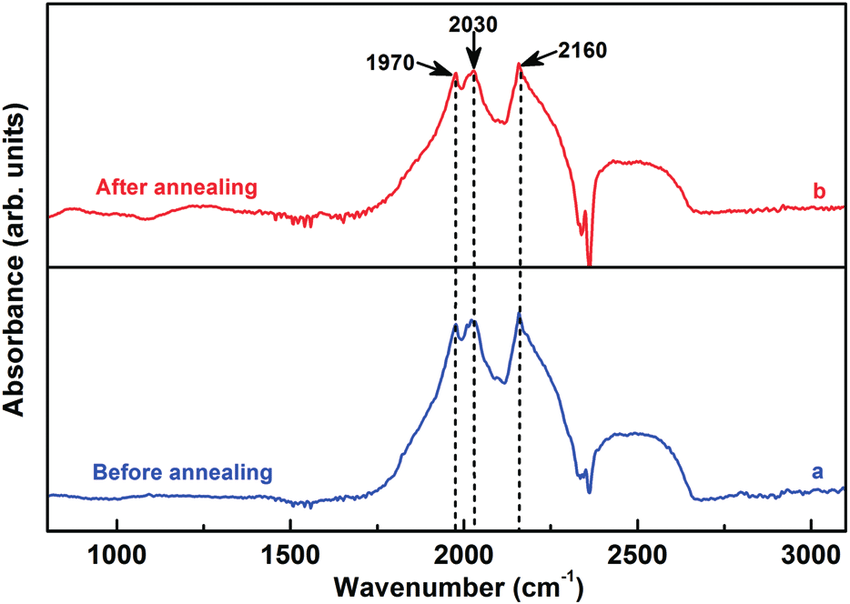Figure: FTIR Sample Output: Diamond Absorption Spectrum (Fang et al., 2018)
(Image sourced from: https://10.1039/c7ce02013a)
Advanced Diamond Characterization Techniques
FTIR (Fourier-Transform Infrared Spectroscopy)
FTIR is used to assess the molecular composition of lab-grown diamonds by detecting impurities such as nitrogen or hydrogen. This method allows us to confirm the type of diamond—Type I or Type II—based on the presence of these impurities. With precise infrared radiation, FTIR reveals important characteristics that determine the purity and overall quality of the diamond. The high sensitivity of this technique ensures accurate identification of chemical bonding within the crystal structure.
Applications:
- Identification of diamond types (Type Ia, Ib, IIa, IIb)
- Detection of impurities like nitrogen and hydrogen
- Quality assessment of diamond seeds and grown diamonds
Raman Spectroscopy
Raman spectroscopy is an essential non-destructive technique for examining the crystal structure of diamonds. By scattering monochromatic light, it provides insights into the vibrational modes of the diamond lattice, revealing both its structural integrity and possible defects. This method is particularly important for verifying that the material is pure diamond and confirming its synthetic or natural origin.
Applications:
- Structural analysis of diamonds
- Verification of diamond origin (synthetic vs. natural)
- Detection of strain or defects in the crystal lattice
Figure: Raman Spectroscopy Sample: Diamond Raman Shift at 1332 cm⁻¹ (Dychalska et al., 2015)
(Image sourced from: https://10.1515/msp-2015-0067)
Figure: Figure: UV-Vis Spectroscopy Example: Absorption Spectrum of Lab-Grown Diamond (Hainschwang et al., 2020)
(Image sourced from:https://doi.org/10.3390/min10100914)
UV-Vis Spectroscopy (Ultraviolet-Visible Spectroscopy)
UV-Vis spectroscopy is used to measure the absorption characteristics of lab-grown diamonds over a range of ultraviolet and visible wavelengths. This helps in understanding the diamond’s optical properties, such as color and transparency. The absorption spectrum is key to identifying the presence of specific impurities, such as nitrogen or boron, which affect the diamond’s coloration and overall quality.
Applications:
- Analysis of diamond transparency and color
- Identification of impurities like nitrogen and boron
- Evaluation of diamond quality through optical properties
SEM (Scanning Electron Microscopy)
SEM is a powerful tool for providing detailed images of the surface of lab-grown diamonds at a high magnification. It allows for the study of surface features and defects with nanometer-level resolution. This technique is crucial for inspecting the growth morphology, surface texture, and any post-growth treatments applied to the diamonds. SEM’s detailed imaging capability ensures a thorough understanding of the diamond’s physical surface characteristics.
Applications:
- Examination of surface morphology and defects
- High-resolution imaging of diamond growth patterns
- Quality control for surface finish and texture
Figure: SEM Sample: Surface Morphology of a Diamond (Zolotukhin et al. 2012)
(Image sourced from: https://10.1166/jno.2012.1210)
Figure: Figure: Optical microscopy sample image of diamond
(Image sourced from:https://www.chm.bris.ac.uk/pt/diamond/mattthesis/chapter2.htm)
Optical Microscopy
Optical microscopy enables the inspection of lab-grown diamonds for inclusions, surface irregularities, and other visual defects. By using magnified optical imaging, this technique helps in ensuring the visual quality of the diamonds, including clarity and the absence of unwanted inclusions. It is an essential tool for quality control during various stages of diamond growth and finishing.
Applications:
- Detection of inclusions and surface irregularities
- Clarity grading and defect identification
- Visual inspection during growth and finishing stages
XRD
X-ray diffraction (XRD) is a critical tool for determining the crystalline structure and phase purity of lab-grown diamonds. By directing X-rays at the diamond, the diffraction pattern created allows us to study its atomic structure, confirming the diamond’s crystallinity and identifying any defects or irregularities. XRD ensures that the grown diamonds possess the desired cubic crystal structure, critical for high-quality synthetic diamonds.
Applications:
- Analysis of crystal structure and orientation
- Verification of diamond phase purity
- Detection of structural defects at the atomic level
PL Spectroscopy
Photoluminescence (PL) spectroscopy is widely used in diamond characterization to detect defects at a quantum level. When the diamond is excited by a light source, it emits light in response, revealing vital information about any electronic impurities or defects present in the material. This method is highly sensitive and is often used to differentiate between natural and lab-grown diamonds, as well as to identify trace elements like nitrogen or silicon.
Applications:
- Identification of electronic and quantum defects
- Differentiation between natural and synthetic diamonds
- Detection of trace elements such as nitrogen and silicon
EDX
EDX is used in conjunction with SEM to provide elemental analysis of diamond surfaces. By analyzing the X-rays emitted from the diamond surface when it is bombarded by an electron beam, EDX identifies and quantifies the elements present in the diamond, such as trace metals or impurities. This information is essential for determining the purity of lab-grown diamonds and ensuring the absence of unwanted elements.
Applications:
- Elemental analysis and identification of trace impurities
- Quality control for elemental composition
- Purity verification of grown diamonds





